The Talent-Driven Recovery
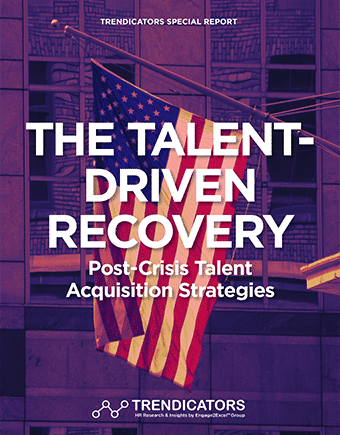
Early April Survey Reveals CEO Confidence Levels and Ability to Sustain a Deep Downturn
One of the greatest challenges for business leaders in dealing with the impacts of the COVID-19 pandemic is that the news keeps literally changing daily. The table below shows the results from a survey conducted April 1-3 of 254 U.S. CEOs. The leaders of companies with revenues from $10 million to $99 million were 3% more confident about business conditions in the next 12 months than they were a year ago. CEOs of smaller and larger companies were only slightly less confident about the year ahead than they were in April 2019. However, when asked how long they could sustain a deep downturn and still stay in business, more than half indicated they could go from six months or longer. Less than half (45%) said they could last six months or less. These perceptions have likely already changed at the time of release for this report. What hasn’t changed is the belief that a recovery period is imminent as soon as the devastating health impacts of the pandemic begin to subside.
This report offers insights on what you can do to maximize the role that talent acquisition can play in optimizing business results during your organization’s recovery period.
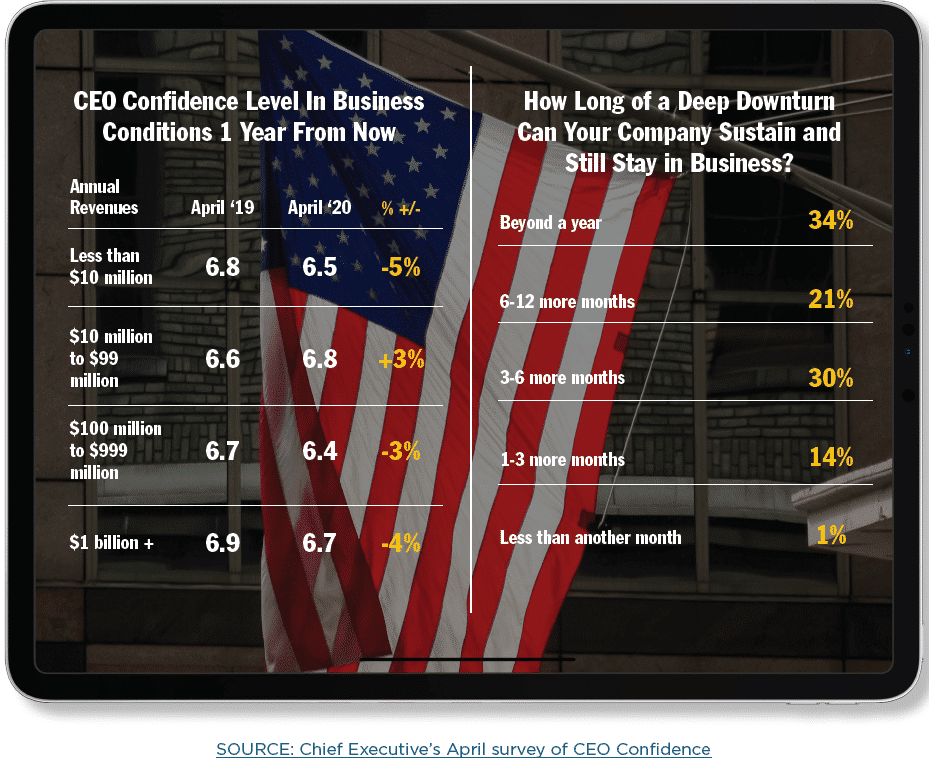
Download
 hbspt.cta.load(123973, '1f5d426c-1cac-435a-a902-6bf0a993a6d0', {});
hbspt.cta.load(123973, '1f5d426c-1cac-435a-a902-6bf0a993a6d0', {});
Getting Ready to Reopen
It has been said many times since the global pandemic began—COVID-19 changes everything. While the death toll and economic consequences of the crisis have been devastating, business leaders must now balance workplace and public safety with financial accountability and strategic leadership in preparing their organizations to reopen in a manner that will optimize wellness, efficiency, productivity and profitability.
Reopening Plans Vary Widely
The definition of reopening varies widely depending on the nature of your business. For essential companies that have sustained society during the crisis, reopening will mean ramping up for increased traffic and a gradual return of work from home (WFH) employees. For others, especially those that underwent significant workforce reductions, reopening will involve a difficult period of emotional recovery along with the need to re-envision the business to align with stakeholder needs and realities in the post-crisis environment. For all organizations, reopening will be a phased process that is influenced by local, state and federal guidelines.
A New Era of Resilient Reinvention
Throughout history, periods of crisis have always been accompanied by spikes in innovation and reinvention. Forced to operate by an entirely new set of rules and diminished resources, many companies have discovered new and sustainable efficiencies to last during and after the recovery period.
In getting ready to reopen, talent acquisition leaders need to reassess what they will do differently, why they will do it, and when it will happen to help their organizations rebound from the impacts of the crisis. The checklist on the right is intended only to stimulate thinking on how you might support a resilient reinvention of your organization.
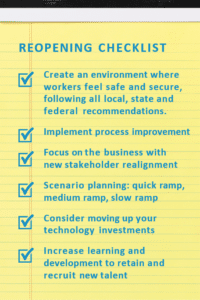
Download
 hbspt.cta.load(123973, '1f5d426c-1cac-435a-a902-6bf0a993a6d0', {});
hbspt.cta.load(123973, '1f5d426c-1cac-435a-a902-6bf0a993a6d0', {});
Post-Crisis Workforce Planning
What Shape Will the Recovery Take?
There is no playbook for workforce planning during the COVID-19 recovery period, nor any clear consensus on what shape the economic recovery will take. A recent survey of C-suite executives by EY provides a snapshot of current perspectives. A V-shaped recovery, which reflects the most optimistic outlook, was predicted by 38% of executives surveyed. A U-shaped recovery, characterized by a long, flat rehabilitation over many months—as occurred during the Great Recession of 2007—was predicted by 54% of those surveyed. Only 8% of C-suite executives predicted an L-shaped recovery—the worst-case scenario, where growth falls and does not recover for years.
While many factors—including the impact of curve-flattening measures, the effectiveness of contact tracing efforts and the distribution of an FDA-approved COVID-19 vaccine—will ultimately determine the shape of the recovery, one thing is clear: workforce planning must be developed using agile models, which will be ready to respond and adapt to changing conditions.
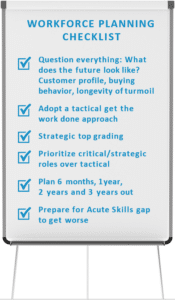
Lessons from the Great Recession
Although the underlying causes of the 2007–9 recession were fundamentally different than what we face today, analyses of the strategies deployed by companies that were the most successful in that recovery provide important insights for post-crisis workforce planning.
Topgrade to Strengthen Decentralized Decisioning: A study by Harvard Business School found that companies that empowered decentralized decision-making outperformed their centralized counterparts in sectors that were hardest hit by the Great Recession. Strategic topgrading for critical roles in the current employment market can have a significant influence on the success of your organization’s recovery strategy.
Focus on Customer Experience: The stock market performance of companies that excelled in customer experience during the recession showed an increase of 6.1% in contrast to a drop in the S&P index of 16% during this period. Even if another wave of layoffs is required, resist across-the-board staff reductions and add talent, or reallocate staff where needed, to improve customer experience.
Look Beyond Layoffs: Companies that emerged from the 2007 recession in the strongest shape relied less on layoffs to cut costs and leaned more on operational improvement. Adopt a tactical approach to making sure the work gets done today, but focus on operational improvement and identify skills gaps today in planning for your recovery in the near- and longer-term.
Download
 hbspt.cta.load(123973, '1f5d426c-1cac-435a-a902-6bf0a993a6d0', {});
hbspt.cta.load(123973, '1f5d426c-1cac-435a-a902-6bf0a993a6d0', {});
Rethinking Candidate Generation
Candidate generation strategies, like all aspects of talent acquisition, must be reengineered for success in the post-COVID-19 recovery period. With the US unemployment rate projected at 16.1% for April, according to a May 3 forecast from the Wall Street Journal, highly qualified candidates are starting to flood the market. However, while talent pipelines will increase exponentially, the sheer volume will make it much more challenging to hire the right people with the right skillsets.
The key to successful candidate generation in times of uncertainty is contingency planning for various recovery and business scenarios, driven by your workforce planning strategy discussed on the previous page. Develop plans for multiple scenarios that will enable you to quickly pivot and make well-thought-out hiring and business decisions at each turn in your company’s road to recovery and post-crisis success.
Rework Job Descriptions
Job descriptions need updating to reflect the new realities of the workplace over the near term and throughout the recovery period. Companies that pulled back on remote work a few years ago are now embracing WFH strategies and giving employees more control over their schedules.
Knowledge, skills and abilities (KSAs) for key roles must also be reassessed to optimize recovery. Many companies will place greater emphasis on hiring multi-skilled employees who are self-managed and self-motivated. And, as the rules of business change and competition increases, a high premium will be placed on innovative thinkers who can generate new ideas and solutions to meet customer needs.
New Sourcing Strategies Inside and Out
Assess your current workforce with a focus on internal mobility and succession planning. Despite the flood of available talent, looking inside to fill open positions should be a top priority. Tap laid off and furloughed employees along with alumni and retirees. Spend time nurturing candidates already in your pipeline. Be transparent and compassionate to make sure candidates know you have not forgotten about them. Invest in building and expanding your talent pools to develop employees in areas that align with your company’s recovery strategy. The WFH pool greatly expands your ability to draw in the best talent regardless of geographic location. This will reduce the cost of recruitment and help identify quality candidates who will drive business results.
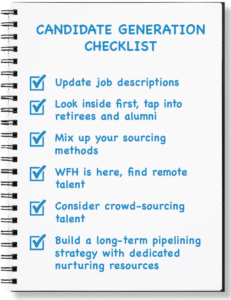
Download
 hbspt.cta.load(123973, '1f5d426c-1cac-435a-a902-6bf0a993a6d0', {});
hbspt.cta.load(123973, '1f5d426c-1cac-435a-a902-6bf0a993a6d0', {});
Preparing for Application Overload
Over the past several years, organizations that invested in improving candidate experiences enjoyed clear competitive advantages when hiring during the lowest period of unemployment in 50 years. The technologies, processes and communications tools used to enhance candidate experiences during the economic boom will become even more critical in optimizing talent acquisition decisions during the impending recessionary period.
Benchmark to Scale More Efficiently
The KPIs used to measure candidate experience represent an important baseline for optimizing candidate intake, regardless of how many openings you need to fill. The key will be to identify choke points, inefficiencies and opportunities for process improvement in order to handle four to five times the volume of applications for each opening. Evaluate your candidate experiences from 2019 for these KPIs:
- Applicant Drop-Off: Identify causes for applicant drop-off and rethink early stage communications. Update career site messaging and be clear about the roles you have open and the terms you’re offering. Accelerate the use of AI to personalize the hiring process and reduce burdens on your team.
- Time-to-Hire: Remove time-wasting steps to avoid losing the most qualified candidates. Keep candidates informed about your new interviewing processes.
- Interview-to-Hire Ratio: If your offer rate was below the 25% industry average, strengthen your screening processes to improve the quality of candidates.
Regardless of when you expect to ramp up hiring, now is the time to improve your processes to enhance candidate experiences and hiring efficiency.
Download
 hbspt.cta.load(123973, '1f5d426c-1cac-435a-a902-6bf0a993a6d0', {});
hbspt.cta.load(123973, '1f5d426c-1cac-435a-a902-6bf0a993a6d0', {});
Prioritizing Candidate Experiences
All brands face myriad challenges in navigating issues around health and safety, supply chain, labor force, customer service and cash flow during the COVID-19 crisis. Companies that can overcome these challenges will end up doing business in a world that is starkly different. Recessions harm consumers, create stress for employees, damage businesses and reset the bar for brand loyalty. Your company will, no doubt, reassess its value proposition for customers based on the new landscape. It is equally important that Employer Value Propositions undergo the same scrutiny.
Your Employer Brand Matters Now More Than Ever
Getting your hiring messaging and candidate experiences right during the crisis and recovery period will have a lasting impact on your employer brand. Companies that understood this in the last recession came back stronger and faster. But the implications and the risks involved in not getting it right are even greater today because of the ubiquitous influence of social media. Be truthful and transparent. And walk in a candidate’s shoes when evaluating messaging and process improvements.
Whether you are in a position to begin hiring now or planning to ramp up recruiting when the timing is right, building and maintaining relationships will be vital for your success. Companies that had the greatest success coming out of the last recession made strategic investments that enabled a faster bounce back. If your talent acquisition infrastructure is out of date, now is the time to invest, taking advantage of significant discounts for a multi-year commitment and building alliances with partners who can drive business impact.
Reduce Friction and Match Volume with Velocity
Use technology to your advantage in reducing friction in the hiring process and enabling the fast action required to capture top talent. And benchmark your hiring experiences against direct and indirect competitors for the roles you seek to fill.
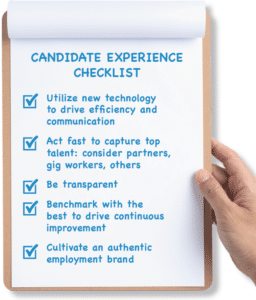
Download
 hbspt.cta.load(123973, '1f5d426c-1cac-435a-a902-6bf0a993a6d0', {});
hbspt.cta.load(123973, '1f5d426c-1cac-435a-a902-6bf0a993a6d0', {});
Embracing Smart Selection
Today, industry-leading brands are using pre-hire assessments to achieve double-digit improvements in quality of hire and retention rates. If your organization hasn’t fully embraced the use of pre-hire assessments, now is the time to upgrade your talent acquisition processes to optimize hiring success.
Pre-hire assessment tools, which have a well-established track record for improving quality of hire, have been available for decades. The science for building and assessing competencies and the legal defensibility of assessments from leading providers have been thoroughly vetted.
Modern Interviewing Platforms Automate the Talent Acquisition Supply Chain
Video interaction has, of course, surged during the crisis, forever changing how employees collaborate, engage with customers and socialize. And now, remote interviewing is a requirement, not a convenience. This has created several challenges. Many hiring managers are not prepared to conduct effective video interviews and require training. Furthermore, many steps in the selection process that were previously associated with in-person interviews now must be conducted online.
The good news is that leading cloud-based enterprise hiring solutions have already integrated many steps in the hiring and selection process into one platform, including assessments, candidate communications, video interviewing and stack ranking tools. The leading platforms also use machine learning, AI and predictive analytics to improve hiring experiences and outcomes.
By embracing smart selection tools, you can more quickly integrate updated job descriptions, automate the vetting of key competencies, create a consistent process and more objectively evaluate candidates.
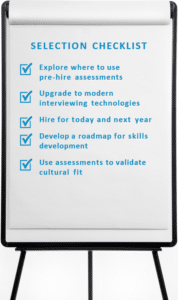
Download
 hbspt.cta.load(123973, '1f5d426c-1cac-435a-a902-6bf0a993a6d0', {});
hbspt.cta.load(123973, '1f5d426c-1cac-435a-a902-6bf0a993a6d0', {});
Reengineering Onboarding
Like each of the other phases in the recruiting processes discussed in this report, onboarding during and after the pandemic crisis should be reimagined to better align with your organization’s go-forward strategy.
Has it been a while since you updated your company’s onboarding program? Have you conducted a thorough evaluation of where improvements can be made? Don’t settle for just virtualizing onboarding the way it used to be done.
A reengineered onboarding process will help you keep recruits engaged and motivated before day one. Effective onboarding should be a “surprise and delight” process.
Preboarding: Provide candidates with an experience that engages them before they accept employment and helps them assimilate into your culture quicker and become more productive in a shorter period of time.
Socialization: Modern onboarding platforms provide employees with their own personalized portal that can contain first day details and welcome messages from their new peers and management team, along with new hire information that will immerse them in the culture before they walk in the door.
Welcome Gifts: Onboarding should go beyond the typical new hire activities, such as completing paperwork, establishing work areas and participating in virtual orientation and training sessions. A welcome gift sent to the employee’s home represents a tangible form of outreach to celebrate an important next step in each employee’s career.
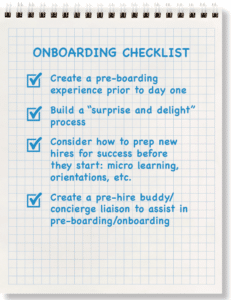
Download
 hbspt.cta.load(123973, '1f5d426c-1cac-435a-a902-6bf0a993a6d0', {});
hbspt.cta.load(123973, '1f5d426c-1cac-435a-a902-6bf0a993a6d0', {});